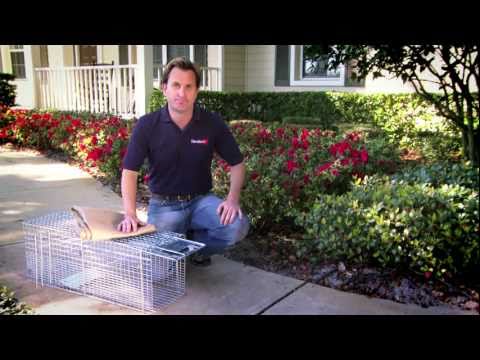





Cat Baits
Cat Baits
Baiting your trap is one of the most important steps in the live trapping process. When baiting your cat trap, it's important to select a bait that cats love - and also position the bait properly. Below, the experts at Havahart® share their top baiting suggestions as well as other useful information and tips about humane cat control.
Best Cat Baits
Cats are most attracted to smelly foods rich in proteins and fats, like oily fish and poultry. A cat uses its heightened sense of smell to seek out food, so the smellier the better.
Some of the best cat baits include:

How to Bait a Cat Trap
After selecting a bait, it is critical that you position it properly in order to achieve a successful capture. If your trap is not properly baited, you may end up with stolen bait or a tripped empty trap.
The best bait placement will:
- Lure the cat all the way inside the trap - body and tail
- Cause the cat to step on the trigger plate when trying to reach it
- Take into consideration the trap type (1 vs. 2 doors):

For a 1 door trap, place the bait towards the closed end of the trap, just behind the trigger plate. Keep the bait as far from the trap walls as possible in order to prevent it from being stolen from the outside.

For a 2 door trap, place the bait towards the middle of the trap to encourage the cat to interact with the trigger plate. You can either place the bait directly onto the plate, bury it in the ground underneath the trap/plate, or hang it from the top of your trap.
Expert Baiting Tips
- Place a very small amount of bait at the mouth of your trap to help lure your cat in. You may even choose to create a bait trail using the juice of your bait to lead the cat inside. However, avoid using too much bait outside of the trap – otherwise your cat may become satisfied before she reaches the trigger plate.
- When dealing with a particularly shy or wary cat, it may help to try to get the cat comfortable with feeding inside the trap before setting it for a catch. Tie the trap doors open and place food inside, replenishing it at the same time each day when she begins to feed on it. After a few days of regular feeding, you may prepare the trap for a catch.
- It's very important to consider every step of the cat trapping process. For more trapping tips, read How to Trap a Cat »
- For more baiting tips, read How to Bait »

Ultimate Cat Protection
Now that you’ve trapped your feral cat, use a repellent to stop cats from coming back. Using a combination of Havahart® traps and repellents gives you the maximum protection you need to keep your yard free of animal intruders!
Critter Ridder® animal repellent has dual application methods - liquid and granular - to provide multi-surface or perimeter barrier protection.


